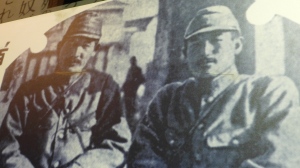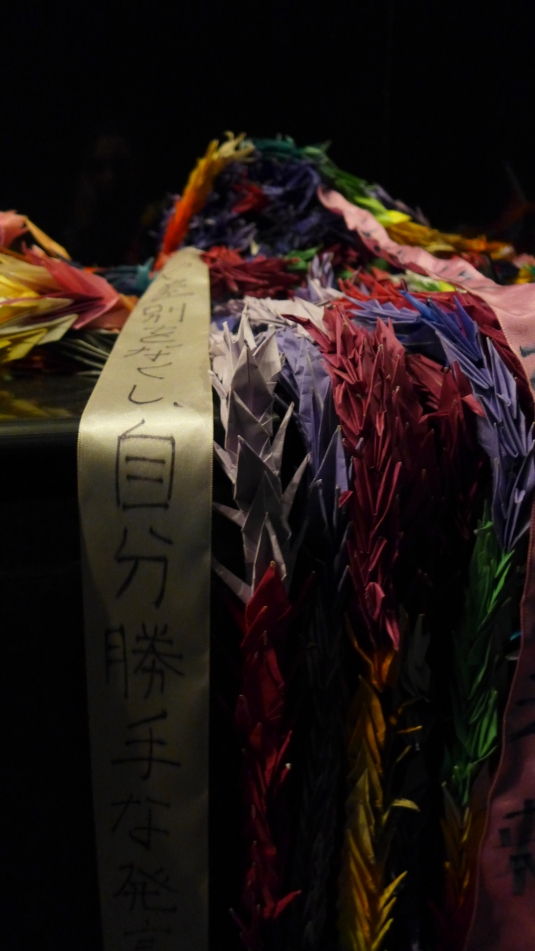I decided that it was time to face something which I had been dreading, the Nanjing Massacre Museum, detailing the mass slaughter of Nanjing civilians by Japanese invading forces during the Second World War (December 13th, 1937). The grey, November sky was a perfect backdrop for our visit to that sombre, black stone building. The first thing that you see as you walk to the entrance is a series of statues, human figures, bodies and faces distorted in various states of pain and panic. Look at the translated plaque beneath them, “The Devils have sent the bombers again, the poor orphans. Frightened by the vicious laugh of the brutal devils, Terrified by the corpses piling up in the alley…” Gritting my teeth, I mentally prepared myself for an afternoon filled with human tragedy and undisguised, volatile hatred towards the perpetrators. Visitors walk past a series of square-cut, grey structures. A monument stands with a repeatedly translated “300,00 victims” cut deeply into the side. Finally inside the museum. One of my group recognises the entrance-way as being built from the stonework from the destroyed old city wall. After an impressive light and sound show simulating a battle-field, we walked through to a room with a wall covered from top to bottom with the names of all the known victims. The character “女“ (nv, female) was written after many of the names, presumably to demonstrate that they are civilians rather than soldiers (I thought it was unnecessary, undoubtedly the males were just as innocent and defenseless). The memorial wall was a beautiful gesture and my defensive stance against the museum relaxed a little.
I waded through the swathes of highschool students in order to stand in front of each individual display, to read the plaques (translated from Chinese into English and Japanese) and to ponder on both the massacre as well as the present-day attitudes towards it. The first thing I noticed was that everything seemed very…disjointed. Each room had a loose theme, but it seemed as though someone had hoarded together everything which had a connection to that period in history and had scattered them throughout the exhibitions in a sort of “Find the Odd One Out” treasure hunt. You are looking at a torch used by a Chinese general moments before being shot in the leg, then you sidle along to the next artifact to read “This is a number plate from a wheel barrow used in 1937.” Wait, what? At best, it was bemusing, at worse, confusing and even insulting. Why would the curator place a photo of three children who had been killed by the invading force, directly next to a photo of the British ambassadors Mini? Are these two things somehow of the same import? How about the photo of a woman who had just been raped, next to a card about China’s financial situation of the times.
Smack bang in the middle of the building is an open mass grave, bones litter the ground and you can go around the outside to read in what horrific ways these people were killed. It was definitely too much, I cannot imagine why the bones needed to be on display, were the curators so desperate to make sure that the evidence was irrefutable that they would display human skeletons from only a couple of generations ago? I assume that these skeletons had not been identified, relatives would not know that their grandmother was down there, permission was not sought. In the same room were gruesome photos of the victims, next to them was a picture of two Japanese soldiers, noted for boasting about killing hundreds of Chinese single handedly. I noticed someone had slashed across their throats in that black and white photo.
It was at this point I just wanted to walk straight out of the museum, indeed two of my friends left quickly after that. When I inquired as to why, they just said that they “got the idea pretty quickly.” However, hold strong and linger at the last couple of rooms. Bland, in comparison to the grand displays of the other rooms, but I stopped and read every bit of text and was very glad for it. A wall of pictures of present day survivors, as well as their testimonies, hung next to the quote “What we must remember is history, not hatred.”- Li Xiuying “要记住历史,不要记住仇恨”-李秀英
Yes…YES!Was this the same museum? I felt like I was suddenly dealing with a whole different place. In that same room, the opposite wall was lined with present-day images and video archives of the people who had taken part in the massacre, with their testimonies. It made a strangely poignant juxtaposition with what we had been shown so far. These old Japanese men, crying and apologising for what had happened, taking full responsibility for their actions, saying that it must never happen again. Both sets of testimonies were used as evidence in the law suit which successfully brought the war criminals to justice. At the memorial site, were piles of paper cranes, folded by Japanese highschool students, wishes for ‘Peace’ were attached to them. A garden, donated by Japan, with a white statue of Lady Peace standing out amongst the grey buildings leads you out and back onto the streets of Nanjing.
My thoughts drifted back to the last thing visitors see before exiting the museum.
“Under the inspiration of the patriotic enthusiasm, we should struggle unceasingly for the construction of socialism with Chinese characteristics, the realisation of the peaceful reunification of our motherland, and the maintenance of world peace.”
I can’t help but feel disgusted by the governments use of a tragedy, the loss of hundreds of thousands of innocent lives, for their own propaganda purposes. They had clumsily added and subtracted from what could have been a poignant reminder of this incident and in doing so, had confused and dulled the lessons taught by history.

